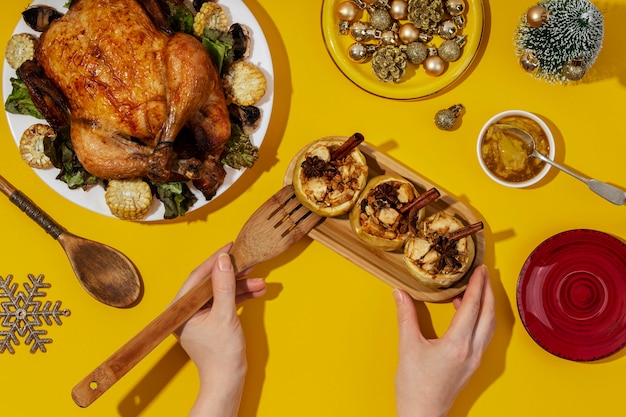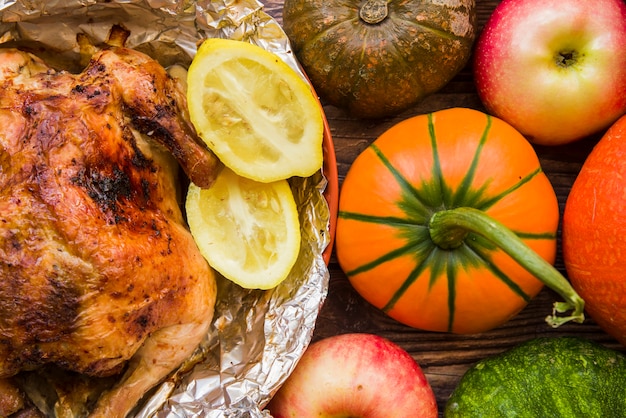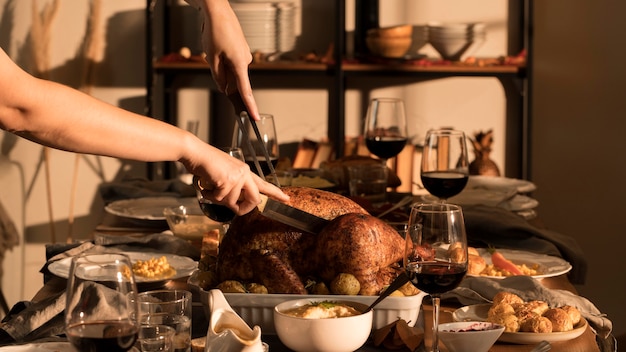(Part 1) The Importance of safe cooking temperatures

Let's face it, no one wants to be on the receiving end of a food poisoning nightmare. Been there, done that, trust me, it's not a good time. And with turkey, well, it's a bit of a tricky beast. It's big, it's dense, and it can take a while to cook right through. That's why ensuring the turkey reaches the correct internal temperature is absolutely essential.
Why Temperature Matters
Think of it like this. Those pesky bacteria we're trying to get rid of are like little party animals, happily multiplying away in a nice, warm environment. But once you crank up the heat, they start to feel the pressure. At a certain temperature, they can no longer thrive and eventually, they give up the ghost. That's why cooking turkey to the right internal temperature is a crucial step in ensuring everyone enjoys a safe and delicious meal.
(Part 2) What Temperature to Cook Turkey To

Now, let's get down to brass tacks. What temperature are we aiming for here? Well, according to the Food Standards Agency, the safe internal temperature for a cooked turkey is 74°C (165°F). That's the magic number, folks. Anything below that and you're taking a gamble.
Why Not Just Cook It to 71°C?
You might be thinking, "Well, the USDA recommends 71°C (160°F), why not just go for that?" And you'd be right, the USDA guidelines are widely accepted, but I've always been a bit more cautious. I'd rather err on the side of safety, especially when it comes to something as delicate as a turkey. Plus, cooking to 74°C ensures that the turkey is cooked through and through, leaving no room for any lingering bacteria. It's all about peace of mind, right?
(Part 3) How to Measure Internal Temperature

Alright, so we know the temperature we're aiming for, but how do we actually measure it? That's where a trusty meat thermometer comes in handy. I've got a whole collection of them, in all shapes and sizes. There's the traditional analogue ones, which I love for their simplicity, and the more modern digital ones, which give you a precise reading in seconds.
Choosing the Right Thermometer
When choosing a meat thermometer, it's important to consider your needs and preferences. If you're looking for a simple and reliable option, an analogue thermometer will do the trick. But if you want precise readings and the convenience of a digital display, a digital thermometer is a great choice.
Where to Insert the Thermometer
Now, don't just go sticking that thermometer anywhere you fancy! There are specific spots you need to target. The most crucial area is the thickest part of the thigh, away from any bone. You want to make sure the temperature reaches that point, as it takes the longest to cook. You can also check the temperature in the breast, just to be extra cautious.
(Part 4) The Importance of Resting
Once the turkey reaches that glorious 74°C, don't jump for joy and start carving just yet! You need to give it a good rest, about 15-20 minutes, before carving. Why? Because the turkey is still cooking internally, and resting allows the heat to redistribute evenly throughout the bird. This helps ensure juicy, tender meat, rather than dry, stringy bits.
The Science Behind Resting
The science behind resting is pretty fascinating. As the turkey cooks, the muscle fibers tighten up, trapping moisture inside. When you let it rest, those fibers relax, releasing the juices and creating a more succulent result. It's like giving the turkey a chance to catch its breath after all that hard work in the oven.
(Part 5) Understanding cooking times
Alright, let's talk turkey cooking times. This is where things can get a bit more complex, as the size and weight of your bird will influence how long it takes to cook. But don't fret, there are some handy guidelines to follow.
The Golden Rule of Turkey Cooking Time
A good rule of thumb is to allow about 20 minutes per pound of turkey for cooking time. So, a 5-pound turkey will take about 100 minutes (or 1 hour and 40 minutes) to cook. However, this is just a general guide. It's always best to check the turkey's internal temperature with a thermometer to ensure it's cooked through.
Factors Influencing Cooking Time
Here are some factors that can affect your turkey's cooking time:
- Stuffing: If you're stuffing your turkey, it will take longer to cook, as the stuffing needs to reach a safe internal temperature of 74°C (165°F) as well. Stuffing adds extra mass to the turkey, which requires more time to cook through.
- Oven Temperature: A higher oven temperature will cook the turkey faster, but it also increases the risk of overcooking the breast. Aim for a moderate temperature of around 180°C (350°F) for best results. This allows the turkey to cook evenly without drying out the breast.
- Shape and Size: A larger turkey will take longer to cook than a smaller one, as there is more mass to cook through. This is why it's crucial to consider the size and shape of your turkey when calculating cooking time.
- Oven Type: Different ovens can have slightly different heat distribution, which can affect cooking times. If you're using a fan-assisted oven, it might cook your turkey faster than a conventional oven.
A Handy turkey cooking time chart
To help you out, here's a handy table with approximate cooking times for different turkey weights:
| Turkey Weight (lb) | Approximate Cooking Time |
|---|---|
| 4-6 | 1 hour 40 minutes - 2 hours |
| 7-9 | 2 hours 15 minutes - 2 hours 45 minutes |
| 10-12 | 2 hours 45 minutes - 3 hours 15 minutes |
Remember, this is just a guide. It's always best to check the turkey's internal temperature to ensure it's cooked through.
(Part 6) Avoiding Common Mistakes
Now, we've all been there, haven't we? We've all made turkey-related blunders in the kitchen. But don't worry, I'm here to help you avoid those common pitfalls.
1. Overcrowding the Oven
One of the biggest mistakes people make is cramming the turkey into the oven with a mountain of other dishes. This can lead to uneven cooking and a less than ideal result. Give your turkey some breathing room, it's a star, it deserves its own space. Think of it like this, you wouldn't cram everyone into a tiny elevator, would you?
2. Not Tying the Legs
I know it looks cute, those little turkey legs dangling out. But trust me, it's a recipe for disaster. Tying the legs together helps the turkey cook evenly and prevents the thighs from drying out. It's like giving the turkey a nice, snug hug, ensuring all the parts cook at the same pace.
3. Over-stuffing
Ah, stuffing, the great debate. Some people love it, others hate it. But one thing's for sure, don't overstuff the turkey. A tightly packed stuffing will prevent the turkey from cooking evenly and could harbour bacteria. It's best to cook your stuffing separately to ensure it reaches a safe temperature. Let the turkey breathe, and give the stuffing its own space to cook properly.
4. Using a Thermometer Not Calibrated for Food
This might seem like a small detail, but it's important to use a thermometer specifically designed for food. Thermometers used for other purposes, like candy or oil, may not be calibrated accurately for measuring meat temperatures.
(Part 7) Tips for a delicious turkey
Now that we've covered the basics, let's talk about making your turkey truly outstanding. Because let's be honest, we're not just aiming for a safe turkey, we're aiming for a delicious one!
1. Brining for Ultimate Juiciness
Brining is a technique that involves soaking the turkey in a salt-water solution before cooking. This helps to retain moisture and creates a juicier, more flavorful bird. It's a bit of a commitment, as it requires a few hours in the fridge, but trust me, it's worth it. The salt draws moisture out of the turkey, then re-absorbs it along with the flavour of the brine, resulting in a wonderfully juicy bird.
2. Patting Dry for crispy skin
Before you pop that turkey in the oven, pat it dry with paper towels. This helps the skin to crisp up beautifully. Moisture inhibits browning, so removing excess moisture from the skin allows it to crisp up nicely in the oven.
3. Roasting on a Rack
Roast your turkey on a rack, not directly on the baking sheet. This allows air to circulate around the bird, helping it to cook evenly and get that gorgeous crispy skin. By lifting the turkey off the baking sheet, you allow heat to reach all sides of the bird, resulting in a more evenly cooked and deliciously crispy skin.
4. Basting for Extra Flavor
Basting your turkey while it's roasting helps to keep it moist and adds extra flavor. You can use butter, oil, broth, or even wine for basting. Basting is like giving your turkey a little drink of flavour, keeping it moist and adding extra deliciousness to the finished product.
5. Letting the Turkey Rest
I know we already talked about this, but it's worth mentioning again. Resting the turkey for 15-20 minutes after cooking is crucial for ensuring juicy, tender meat. So, patience is key here, my friends.
(Part 8) FAQs
Now, you might be wondering a few things, so let's address some common questions:
1. Can I cook a frozen turkey?
You can definitely cook a frozen turkey, but you'll need to give it extra time to thaw completely before cooking. A general rule of thumb is to allow 24 hours per 5 pounds of turkey for thawing in the refrigerator. It's best to thaw the turkey in the refrigerator for safety reasons. Thawing at room temperature or in a microwave can lead to bacterial growth.
2. What if I overcook the turkey?
If you overcook the turkey, the breast will become dry and tough. Unfortunately, there's not much you can do to fix this, but you can try serving it with a flavorful gravy to add moisture. To prevent overcooking, it's crucial to keep a close eye on the temperature and remove the turkey from the oven when it reaches the desired internal temperature.
3. Can I reheat a cooked turkey?
Yes, you can reheat a cooked turkey, but it's best to do so within 3 days of cooking. Reheat it in the oven at 160°C (325°F) until it reaches an internal temperature of 74°C (165°F). Reheating turkey is a good way to use leftovers, but remember to reheat it thoroughly to ensure it's safe to eat.
4. How long can I store cooked turkey?
Cooked turkey can be stored in the refrigerator for up to 3 days or in the freezer for up to 2 months. Make sure to store leftover turkey in airtight containers to prevent freezer burn and maintain its quality.
5. Can I cook a turkey in a slow cooker?
You can definitely cook a turkey in a slow cooker, and it's a great way to get a super-tender bird. However, you'll need to check the size of your slow cooker to ensure it can accommodate a turkey of the size you want to cook. Cooking turkey in a slow cooker is a great option for a hands-off approach, but make sure to follow the manufacturer's instructions for safe and successful cooking.
(Part 9) Conclusion
And there you have it, folks. A comprehensive guide to cooking a safe and delicious turkey. Remember, it's all about those internal temperatures, those rest periods, and those little tips and tricks that make all the difference. So go forth, my friends, conquer the kitchen, and create a Christmas feast to remember. Happy turkey time!
Everyone is watching

How to Cook Frozen Lobster Tails Perfectly: A Step-by-Step Guide
RecipesLobster. Just the word conjures up images of lavish meals, special occasions, and a taste of luxury. But let's...

Pigs in a Blanket Cooking Time: How Long to Bake for Perfect Results
RecipesAh, pigs in a blanket. Just the name conjures up images of those delightful little parcels of crispy pastry en...

Pork Fillet Cooking Time: How Long to Cook It Perfectly
RecipesPork fillet, or tenderloin as it's sometimes called, is a real favourite in our house. It's so versatile, and...

The Ultimate Guide to Tender, Juicy Pulled Pork
RecipesRight, let's talk pulled pork. It's one of those dishes that just screams "comfort food," doesn't it? I mean...

The Ultimate Guide to Cooking Delicious Frankfurters
RecipesLet's face it, we all love a good frankfurter. It's a classic, simple, and always satisfying. But let's be rea...
